Module 14: Hiring and Working with a Woodland Contractor
This home study module is intended to assist you, a woodland owner, with choosing and working with a contractor in order to enhance the stewardship of your woodland.
Managing your woodland property can be an exciting task! It can be an educational, informative and rewarding experience, but it may not always be easy. Other modules in this series have described the degrees of complexity that are apt to confront you as you work towards stewardship of your woodland.
Forests are a delicate balance of natural processes. As we learned in Module 7 (Woodlot Ecology: Your Living Woodlot), life is abundant everywhere in a forest, and it requires knowledgeable and carefully considered approaches to avoid damaging complex and often fragile ecosystems.
In Module 1A we learned that proper planning is the first step on the road to progressive stewardship of your woodland. We have looked at the ways in which the web of life can be managed to produce both timber and non-timber products. We’ve seen the importance of maintaining clean water and healthy soils while we are managing for other resources which have important values.
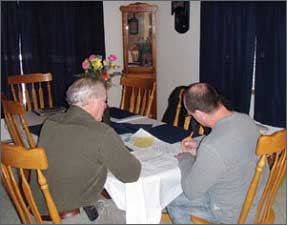
It is important to remember as an owner, your objectives for your woodland are a primary goal. Through responsible stewardship you can reach those objectives, but it may be difficult to accomplish all your objectives without assistance. From time to time you may need help with work which requires specialized knowledge and equipment.
For that reason, this module has been written to introduce you to the practice of hiring and working with contractors who are in the business of woodland management. Woodland contractors have the experience and equipment needed to help you achieve your goals and objectives.
An important first step is to plan your work and work your plan.
Module 14 - Lesson 1 - Planning for Success
Perhaps the most important part of working with a contractor is your communication before the work gets started. Whether the contractor is going to undertake to do silviculture, harvesting or road construction work, spending some time sitting at the kitchen table will enhance the contractor’s understanding of what you want. You will also gain knowledge of the contractor’s capacity for doing the work.
First, you should review your woodland stewardship plan. This document lays the foundation for all the work on your property, and should be a logical starting point for any discussion with a contractor. Show the contractor the map or aerial photo of your woodland, and mark the proposed work area clearly. You should provide the contractor with a copy of the map and outlined area.
If you have differences of opinion regarding where the work should be done, or at what rate, it may be prudent to visit the site on the ground and discuss the details. A forest professional can act on your behalf if you cannot visit the site personally. If a site is to be marked with flagging tape before the work begins, a forest professional can do this too.
 |
| Planning work on the ground includes flagging trees and sites that may have special significance. |
It is at the planning stage that you should make any special wishes known to the contractor. Perhaps you would like certain trees or areas of trees left standing. If some areas of the work site are significant to you – such as the presence of old structure foundations or even a small family cemetery – make your concerns known to the contractor.
Planning for Safety
You should also inform the contractor of any hazards which may be present on the property, such as old wells, garbage dumps, and road gates and cables. You should mark these potential hazards clearly with flagging tape or bright paint. Warning signs can also be used to alert workers and other individuals of potentially unsafe areas on your property. Reducing the likelihood of injury and limiting your liability risk is paramount in getting the job completed satisfactorily.
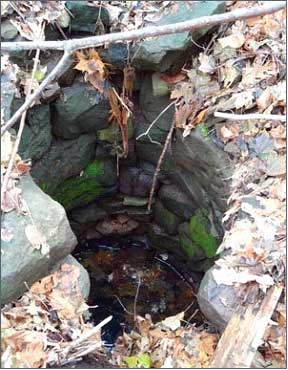 |
| Old wells, if unmarked, may present hazards to contractors and the general public. |
What Kind of Contractor Do You Need?
First, study your stewardship plan
Your woodland stewardship plan should have a detailed list of work to be carried out on your woodland over the next several years. If you do not have a stewardship plan, refer to Module 1A. The woodland plan map should identify the kinds of work that can be done in areas of your property.
If you need confirmation of whether a particular treatment is suitable, it is a good idea to contact a forest professional, who can carry out a pre-treatment assessment (PTA) and verify your work plans. These individuals are trained to recognize and recommend forest improvement work. Some work, such as harvesting and commercial thinning – because they require the extraction of wood products - may require suitable ground conditions and may be seasonal. For this reason it is good to ascertain whether timing is an issue.
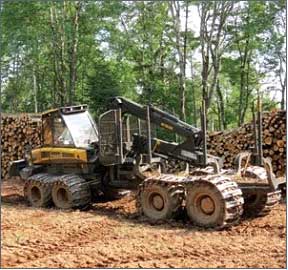 |
| The extraction of wood may be limited to certain seasons when using heavy equipment. |
Other forestry work that does not require the use of heavy equipment may not have the same seasonal restrictions. These include:
Pre-commercial thinning (PCT);
Tree planting (best done in the spring or fall);
Early competition control (sometimes called manual weeding); and
Boundary line maintenance.
For most of these treatments there may be opportunities to receive financial assistance. Refer to the Additional Resources near the back of this module for further information.
Gaining access: road construction contractors
You may first need to consider the services of a road construction contractor should you require a new road or if an existing road is to be upgraded to access your woodland. Road contractors usually employ excavators and bulldozers to carry out their work. It is important to remember most roads need time to “set up” after construction. It may take several months for a road to drain and dry out sufficiently to enable logging trucks to travel on its surface. Keep this in mind when you are talking with a harvesting contractor, since an expensive road can be ruined in a short time.
Ensure your road construction contractor has access to maps of your woodland so he can clearly see the layout of your property, and where the road must be located to access areas of forestry work. Keep in mind a shorter road may not mean a cheaper road. The installation of culverts and watercourse crossings may greatly increase the cost of your road.
The centerline of the road should be flagged to indicate the route that will be taken. If a road right- of-way must be cut, the sidelines should be flagged so that the opening for the road is neither too narrow nor too wide. A width of 15 to 20 meters will ensure the roadbed receives full sunlight, which should dry the road surface and allow earlier access each spring. A forest professional who is familiar with your woodland is often the best choice to lay out the road location and dimensions. Refer to Module 11 for further information on road construction.
 |
|
| A well-built road is a key component of successful woodland stewardship. | |
You may first require a harvesting contractor to cut the road right-of-way for the road contractor. Make sure the width of the right-of-way is cut no wider than the sideline flagging, unless you have prior agreement with the harvesting contractor on this issue. If the wood is piled within the right-of-way it should be located so it is not in the way of road construction and, once the road is built, a logging truck will have no problems reaching it. A forest professional can help supervise the harvesting of the right-of-way and the construction of the road.
Building a road across a watercourse, or crossing a watercourse with heavy equipment requires a permit from Nova Scotia Department of Environment. Permits are usually issued only to individuals who have received watercourse alteration training, and are certified. A number of forest professionals and road construction contractors possess this certification. Contact the Department of Environment for a list of certified individuals. For more information on road construction see Lesson 2 of this module.
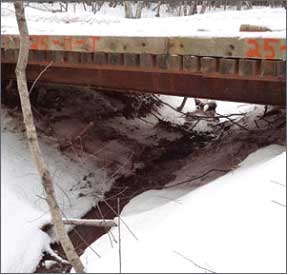 |
| Proper temporary crossings are mandatory for wood forwarding and trucking. |
Finding the Right Contractor
Once you have decided which type of work you wish to do on your woodland, how do you find the right contractor for the job? Perhaps the best and most frequently used search method is by word-of-mouth. Woodland owners who have successfully used contractors with good results are not hesitant about recommending them to other woodland owners.
Talk with your neighbours
Get to know some active woodland owners in your area and you will find a wealth of information about more than just contractors. Other woodland owners - particularly those who work extensively on their own properties - can tell you about forest products market conditions, which mill is paying the best rates, and ways in which they have successfully tackled problems on their own properties. They may share their knowledge about local wildlife, where to get funding assistance and even how to properly sharpen a chainsaw. Get to know some fellow woodland owners – you’ll be glad you did!
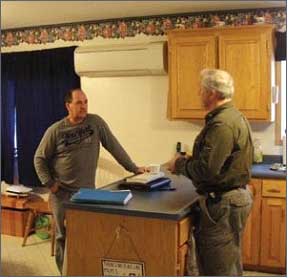 |
|
Your neighbours may be able to recommend good woodland contactors. |
Do your research
Contractors are business-people, and many of them advertise their services. Sometimes your local daily or weekly paper will have ads placed by woodland contractors looking for a continuous supply of work. Contractors may also advertise online, including
on the Forest Service Directory (www.FSDB.com). This useful website lists contractors by service type. The site also lists forest professionals who wish to advertise their services. Check it out!
Have reasonable expectations
At some point you may wish to ask yourself, “What is most important about my woodland – the quality of the work, or a high stumpage payment?” Often there must be trade-offs. Remember contractors have a business to run. If you encounter a contractor who appears to make big promises, you should get those pledges in writing, and perhaps add them to your job contract.
It can be difficult to find exactly the right woodland contractor that meets your every need. You, as the landowner, must be reasonable in your expectations. Does a stumpage rate sound too low? Ask around, get some quotes from other contractors, and you might be surprised at the variety of responses you receive. Do you want to harvest every last tree on your property for maximum income? Read the provincial Wildlife Habitat and Watercourse Regulations and you may find that this is impossible.
The adage “If it sounds too good to be true, it probably is,” holds true in many circumstances, including woodland management.
If you have high expectations and you cannot find a contractor that meets your needs, it may be time
to become a contractor yourself. You could find that controlling costs while undertaking the perfect job can be challenging, particularly if you invest in expensive equipment.
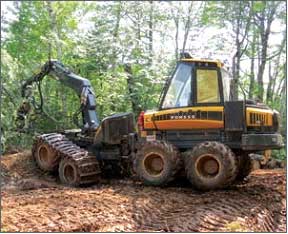 |
| It is important to determine whether your potential contractor has the proper equipment for the job. |
Evaluate Your
Getting Involved
As a woodland owner, how involved should you be with a contractor and their job? Are you a landowner who prefers to work closely with a contractor, perhaps even doing some of the work yourself? If so, it is important to confirm the contractor is okay with your participation.
Most contractors have their own unique approach to completing a job and although some may welcome your involvement, others may not. Silviculture contractors are aware of the criteria and standards for silviculture and want to ensure the standards are met. Unless you are familiar with these standards, and the type of equipment needed to complete the job, it is difficult to work with a woodland contractor to their satisfaction.
It is usually better to stay at arm’s-length to a contractor and frequently monitor his or her activity to ensure that the standards of your contract are being met. They know how to do the work best. Let them do so.
 |
| Contractors and machine operators are knowledgeable and are usually willing to discuss woodland management options. |
Being Your Own Contractor
Some woodland owners, if they have the time and experience, decide to carry out their own work as the contractor. These folks are often called owner-operators.
By hiring your own workers you can often get work done at less expense, but experience and an investment in specialized equipment may be necessary if you wish to follow this path. Ultimately, you will be responsible for the quality of the job, keeping your workers motivated and carrying the proper insurance. If it is a harvesting job, you may also be responsible for forwarding wood to roadside, making arrangements for trucking, and ensuring that mill specifications on the wood are met. For any kind of work you must be accountable for worker safety and job quality standards.
Does this sound like a tall order? It can be, and woodland owners are often surprised by the intensive nature of being their own contractor and the attention to detail that it requires. It’s not for everyone, but it could be for you!
Are You an Absentee Woodland Owner?
Living hundreds or thousands of kilometers from your woodland can make it challenging to manage your woodland properly. It may be impossible to meet with contractors face-to-face.
Through emails and teleconferencing, absentee landowners can learn about the progress of work on their woodlands in real-time. Photos and videos of work being done can provide some assurance that many details of a contract are being met. Such electronic communication is common practice amongst most woodland contractors and forest professionals, but this too should be included in a contract.
Forest professionals can reduce much of the guesswork and uncertainty that go hand-in-hand with being an absentee woodland owner. A professional can arrange the details of harvesting and silviculture contracts, supervise work and generally look after your woodland management interests in your absence.
 |
| Hiring a forest professional is often a good choice for absentee woodland owners. |
Module 14 - Lesson 1 - Case Study 1
Sally and George Wood are avid fly fishermen. In particular, they enjoyed fishing for Atlantic salmon, to the point of spending two weeks every summer on the Margaree River in Cape Breton. Because they are non-residents they required a guide, whom they hired every year and whose name is John.
The Woods are from Massachusetts, and each year stayed at a bed-and-breakfast in Northeast Margaree. They were always sorry to leave, not just because of the fishing, but because they enjoyed the great hospitality extended to them each time they visited Cape Breton.
One January they had a call from John, their guide, who usually spent the winter guiding bonefish anglers in Key West. John told them he had heard a 61-hectare (150-acre) property was for sale in the Margaree Valley, but it was undeveloped and “off the beaten track”. A call to a real estate agent in Margaree Harbour confirmed the property was indeed for sale and “would they like to pop up and have a look at it?” Although this was out of the question, the Woods made arrangements to purchase the property immediately.
On their next trip to the Margaree, the Woods were anxious to view their new acquisition. With the help of their B&B host and a topographic map, they set out on their voyage of discovery. They soon found their rented SUV was adequate to the task of taking them across a washed-out culvert, down a rutted road, and around a mountain to where their property was situated.
The road ended in a maze of alders, but George and Sally found a real estate sign face-down in the ditch and knew they had arrived. A quick hike through the alders and into an overgrown field confirmed their greatest hopes: they were owners of a woodland property near the Margaree River!
 |
The sun was sinking low as George and Sally climbed the path that followed the sparkling stream into the side of the mountain. George, with sweat stinging his eyes, noticed flashes of gold in all directions. The sun was playing tricks.
But no, the trees actually appeared to be made of sheets of gold. Looking closer, it was a species of birch George did not recognize, with bark that was tighter and shinier than the paper birch back in Massachusetts. Well, he was intrigued.
The next morning George awoke excited. He let John guide Sally down to their favorite pool while he phoned an old acquaintance in Baddeck. “Where can I find out more about my property?” he asked.
“There is a local forest owners’ partnership,” his friend replied. “They’ve helped me on many occasions and I’m sure they would be happy to help you too.”
It took a couple of tries, but on the second call a forest technician named Barry answered. George identified himself and mentioned he had just acquired a property in the Margaree Valley. “Can you come out and have a look?” asked George. Tomorrow, replied Barry.
While George wasn’t keen on missing two fishing days in a row, he met Barry near the washed-out culvert. “I’ll have to hitch a ride with you from here,” said Barry as he got out of his Corolla and got into the passenger seat of the SUV. They drove as far as the road would take them, and struck off through the alders. A snipe thundered past them as they entered the tangle of alders and hawthorn trees. “That’s a good sign,” stated Barry.
As they walked through the old field, a dark bird rose from the tall grass in front of them and glided down the hill. “Northern harrier,” said Barry. “They’re good for keeping the mice population down. There must be a nest close by.” They watched as the raptor winged slowly across the hillside, its white tail patch stark against the backdrop of trees, seemingly in no great hurry.
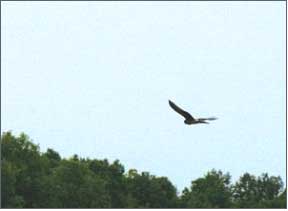 Entering the edge of the woods, the trees stretched away on either side. “You’ve got a great property here,” said Barry. “There is good quality sugar maple and yellow birch which have tremendous potential, and plenty of poor quality balsam fir which should be harvested soon because it has begun to decline in growth and has developed heart rot.”
Entering the edge of the woods, the trees stretched away on either side. “You’ve got a great property here,” said Barry. “There is good quality sugar maple and yellow birch which have tremendous potential, and plenty of poor quality balsam fir which should be harvested soon because it has begun to decline in growth and has developed heart rot.”
“Yellow what?” asked George.
As Barry explained the growth characteristics and habitat of yellow birch, George could see it would take this kind of specialized knowledge to properly manage his woodland. As they walked back to the vehicle, George was convinced letting experts such as Barry manage their woodland was the best way forward. Barry suggested a stewardship plan would be a good first step. After a conversation with Sally over supper at the B&B, in which she agreed to proceed, George phoned Barry on his cell phone. “Okay, let’s go ahead with a stewardship plan,” he stated.
With the excitement of landing five salmon etched in their memories, George and Sally returned to Massachusetts at the end of the
second week. By the end of September, Barry had emailed them a stewardship plan for their approval. By teleconference, they discussed the possibilities of building a road into the property. “You really only need to upgrade the existing road,” said Barry. “It will be a lot less expensive than a new road.”
“But isn’t there a better route?” asked George.
“The old folks usually knew the best locations for roads,” replied Barry. “Once there are proper ditches, you’ll think it was a brand new road. I can arrange a contractor if you’d like.”
A contract was exchanged by email and the work began that fall. Every week, Barry would send George updated photos of the road. Once the ditches were in place, the road surface dried out almost immediately. As the road was extended into the old field, Barry was careful to steer its route away from the nesting area of the harrier. Those birds were valuable in keeping down the field mice and vole populations that were a menace to young tree plantations. While the raptors were not nesting this late in the season, they often returned to the same area each year.
The following spring, George was anxious to find out how his road had weathered the winter. “Just fine,” said Barry. “And once the sap settles down, we can start thinking about getting some of that fir out of the hardwood, and really putting your road to work. We have a harvesting contractor that specializes in that sort of treatment, and we have good markets for the fir as soon as we can truck it.”
“Do we need to sign another contract?” asked George.
“No, you’ve already got a contract with our partnership, so that’s all we need,” replied Barry.
As the year progressed, the Wood property became a beehive of activity. A local contractor carried out a selection harvest over much of the property, and George was pleasantly surprised by the after-tax stumpage cheque he received for the harvested over-mature fir. “Time for new fishing gear,” he said.
“Time to think about building a cabin,” Sally replied.
The cabin has been gazing over the Margaree River for more than ten years now, and the Woods return each summer to fish and relax and walk in their woodland. George’s favorite tree is yellow birch, and he and Sally have chosen and pruned more than a thousand trees in their walks together. As they sit on the porch, they can almost see the salmon holding in the pools.
But best of all, their cabin is still wonderfully free of mice.
Module 14 - Lesson 1 Quiz
| Questions: | 10 |
| Attempts allowed: | Unlimited |
| Available: | Always |
| Pass rate: | 75 % |
| Backwards navigation: | Allowed |
Module 14 - Lesson 2 - Woodland Roads: Vital Links for your Contractor
Well-constructed and maintained woodland roads are crucial for efficient movement of both wood and workers. Roads are also a vital safety link should incidents occur when quick transport to and from work sites is needed. For this reason, you should pay particular attention to the condition of your roads.
If wood is to be transported from your woodland site to a mill or wood yard, you will likely need a road. New roads can be built where none have existed before, or old roads and trails can be upgraded to meet the requirements of logging trucks. If you already have a woodland access road, ensure it is adequate to accommodate modern semi-trailers. Pay particular attention to the width of the entrance at the main road, and the size of the turnarounds (if needed). While some truckers are willing to back their vehicles a short distance, others are not. You should also be aware that a permit from the Nova Scotia Department of Transportation and Infrastructure Renewal is required to construct a new road entrance.
 |
| Good woodland roads are vital links for contractors. |
Road requirements should be thoroughly discussed with your harvesting or silviculture contractor. Ensure the road meets the contractor’s needs. If road upgrading needs to be done prior to the contractor beginning work, clarify who will bear the cost of this work. Also discuss the possibility the road may deteriorate through use, or while the contractor is using it, and reach an agreement on who is responsible for maintaining the road in a trafficable condition. For your own protection, it may be advisable to take photos of your road, particularly if it is new, which can help in avoiding disputes over the original condition of the road.
To keep costs down, it may be a good time to think about excavating one or more ponds while the road-building equipment is on site. Ponds can be real hotspots for wildlife and also provide a measure of safety when dealing with potential forest fires.
An Ounce of Prevention
Heavy forestry equipment can easily damage the surface of a woodland road during wet seasons of the year of if the road is relatively new. Forwarders (porters) loaded with wood should avoid travelling on roads which are to be used for trucking. In many cases, wood can be piled at roadside from the back (off-road) side, so that road damage is avoided. If road damage from equipment is a concern, mention it to the harvesting contractor.
Keep in mind that woodland harvests can greatly increase water runoff from a site. Ensure the road ditches and culverts can handle increased peak flowage. Knowledgeable contractors will recommend replacement of inadequate or damaged culverts, and will keep an eye out for potential ditch blockages and culvert obstructions. If culvert or bridge work is required on watercourses, make sure qualified personnel supervise the work, including individuals which are certified in watercourse alteration. A little extra caution can go a long way towards preventing unnecessary damage!
 |
| Proper road construction is a key element in woodland stewardship. |
For advice and information on woodland road funding assistance, contact Forest Products Association of Nova Scotia, whose contact details are found in the Additional Resources section of this module.
Crossing Other Properties
It is sometimes necessary to cross a neighbouring property to access some areas of your woodland.
If this is the case, an agreement between yourself and the owner of the property should be arranged. As with all contracts, it is preferable to have an agreement in writing, rather than verbal consent.
Temporary rights-of-way are fairly common in forestry operations. Often a contractor will prove to be valuable in gaining permission to cross neighbouring property if he or she has a solid reputation for fairness and good quality work. If a contractor indicates he already has permission to cross adjoining land, ask to see the signed agreement.
Absentee landowners can be difficult to contact when permission is sought to cross their land. Every attempt should be made to speak with them directly, or to an agent who may be handling their affairs. If language is a barrier and there is no local agent, it may be best to contact a lawyer who will ensure that contact is made.
Rights-of-Way
If wood is to be extracted over neighbouring land, you or the contractor should make it clear to the owner any damage to their property will be repaired. This should be indicated in the right- of-way agreement. If, in your contract with your forestry contractor, he is held responsible for repair work, the contractor will go to extra lengths to prevent damage from occurring in the first place.
In some instances – and if it is in his interests – the contractor may be able to access future work on the neighbouring property, further benefitting all parties.
The actual right-of-way should be clearly marked with flagging tape, to avoid misunderstandings about its location. If trees must be harvested to clear a right-of-way, a fair stumpage value should be paid to the neighbouring woodland owner.
In some instances woodland owners may wish to be paid an access fee that is over and above the stumpage value of the wood harvested from a right-of-way. This fee might be demanded to cover the lost potential revenue of immature trees which are cleared from the right-of-way, or may simply be payment for access. It is important to discuss the benefits and disadvantages of all aspects of a right-of-way with your contractor.
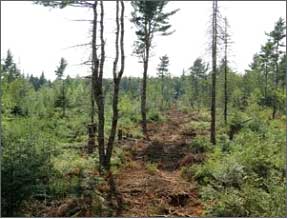 |
| Any right-of-way crossing an adjacent property should be described in a written agreement. |
Reducing Your Risks
Once you have located one or more woodland contractors who appear to suit your needs, you should ask for credentials which prove a contractor’s level of capability. Accessing funding assistance for silviculture or road construction may require credentials. Such credentials can include, but are not limited to:
- Forest professionals, including Certified Forest Technicians and Registered Professional Foresters
- Forestry training, including silviculture training;
- Nova Scotia’s Forest Ecosystem Classification training;
- Certification, including Atlantic Master Logger certification
- First aid training;
- WHMIS training;
- Watercourse alteration certification;
- Letter of Good standing with Workers Compensation Board of Nova Scotia; and
- Any other training or certification which increases your confidence in the contractor’s ability to deliver excellent forestry work
You should not feel pressured to carry out forestry work that is different from or not recommended in your woodland stewardship plan. If a contractor is adamant extra work should be done, or your plan should be changed, you should ask for another opinion. A forest professional should be able to give you his or her objective opinion.
Get it in Writing
Congratulations! You’ve found the right contractor, but now what? One of the first things you should do - no matter how sincere a contractor may appear - is take steps to reduce your risks of loss due to property damage or personal injury. This can be accomplished through the use of a contract, which is a legally binding obligation to perform to a defined level of expectation. The contract is binding upon both the landowner and the contractor.
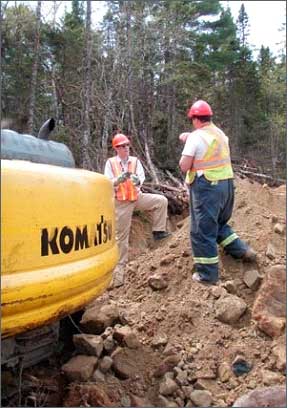 |
| It is important to have a legally binding contract in place before work begins. |
The Contract: the Core of Your Contractor Relationship
When you are working with a contractor, no other instrument is as effective as a rigorous and thorough contract. By setting out the responsibilities of each party, a well-written contract will protect both yourself and the contractor from anticipated and even unanticipated events and results.
Many contracts are made verbally, but it is much better to go the extra step and have a written contract. It is also advisable to have a third-party witness who is aware of the details of the contract.
A good contract will contain the following information:
1. Details of Job:
The job itself can be described by:
- Area, if it is silviculture or harvesting work.
- For example, the area could be 10 hectares (25 acres) in size.
- Treatment description. For example, the treatment may be selection harvesting, or clear-cutting, or shelterwood.
- Boundaries. For example, the job may be bounded by a stream, boundary line or road.
There may be other preferences or limiting factors, examples being:
- Leaving firewood standing for owner’s personal use;
- Closing of road gate each night;
- Harvesting only balsam fir, leaving all red spruce standing, if not interfering with operation;
- Removing all harvested wood from property by a certain date;
- Keeping road and landing clear of debris.
- Maintaining adequate fire equipment on site;
- Ecosystem-based management with pre- and post-treatment assessments;
- For absentee landowners, how the progress of the work will be communicated; and
- The type of equipment to be used in carrying out the job.
2. Details of Payments
- To contractor: if woodland owner is paying for silviculture treatments, road construction or other service
- To woodland owner: if contractor is paying for standing wood (stumpage)
The contract should also indicate how the payments will be made (through bank account, cheque or other means) and how often payments will be made. For instance, wood payment may be made: (a) as a lump-sum up front, (b) as the wood is sold within a specified time limit or (c) at regular intervals – for instance, every two weeks or every month. There may be other methods of payment which are acceptable to both parties.
You should contact your accountant to determine the best payment option for your particular circumstance.
The payment should also indicate whether there are any additional check-offs or deductions, which may include the costs of planned future silviculture treatments or other expenses.
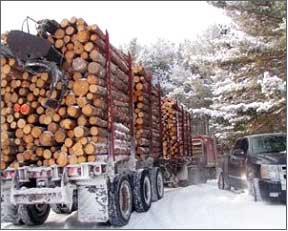 |
| Payment details for harvested wood should be carefully laid out in a contract. |
3. Responsibilities of Each Party
This section of the contract should outline the duties of the contractor and woodland owner. It should answer questions similar to the following:
- Who will repair the road if damaged?
- Who will look after the sale of the wood?
- Who will mark the operations area?
- Who will be responsible for follow-up treatments, including site regeneration such as tree planting?
4. How Any Potential Conflicts Will Be Resolved.
To be effective, a contract should be CLEAR, CONCISE and COMPREHENSIVE.
While unexpected results and events will occur, a contract will assist in solidifying the business relationship between yourself and the contractor.
See Appendix 1 for a sample harvesting contract. While this sample contract may seem basic, it could be a good foundation on which to build a more comprehensive, detailed contract.
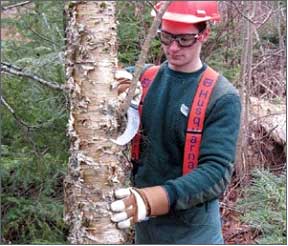 |
| All woodland stewardship work, including silviculture such as crop tree pruning, should be initiated by a contract. |
Insurance: Reducing Your Liability Risk
Most woodland contractors carry some insurance. This is an essential element of working on property which they do not own themselves. Adequate insurance is necessary to protect contractors and their employees, and it may also protect you as a landowner.
Workers Compensation Insurance
All persons working to earn an income in Nova Scotia must have Workers Compensation Insurance. This basic insurance can provide a worker with coverage should he or she be unable to continue working due to a workplace injury. Depending on the type of work being done, premium rates can vary greatly. It is very important you check with your contractor to ensure both the contractor and his or her workers have Workers Compensation Insurance. This will protect you from incurring expenses associated with workplace accidents on your woodland. It is a good idea to make it a condition of any contract the contractor carries this insurance, and for the proper class of work. You should ask the contractor for a copy of a Letter of Good Standing from the Workers Compensation Board of Nova Scotia, as proof the contractor’s premiums have been paid for the year. It should be noted that even if you are working on your own woodland you may require Workers Compensation insurance.
Public Liability and Property Damage Insurance
Whenever you cause damage to another person, or another person’s property, you may incur liability for damages. Public Liability Insurance helps protect you from consequent actions resulting from the damage.
It is not difficult to realize all contractors working on other persons’ properties should carry Public Liability and Property Damage Insurance. This insurance may provide coverage should a contractor accidentally harvest trees on an adjacent property, or cause damage to other properties through silt runoff, equipment fuel leaks or forest fire. It is important to specify the types of damage that a contractor’s insurance premium will cover, since not all Public Liability Insurance is the same. If you need more information, contact your insurance company. It is usually recommended that a specified minimum amount in coverage be carried by a woodland contractor. Your contract should indicate both the type and extent of coverage.
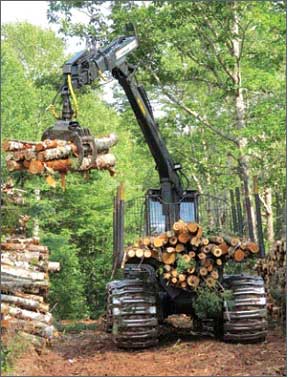 |
| Insurance coverage is a key component of a woodland stewardship contract. |
Due Diligence: Your Greatest Responsibility
No amount of insurance can replace common sense and due diligence. It is incumbent upon you, the woodland owner, to ensure the risks of injury are reduced for anyone working on or using your property. If, for example, you have not told your contractor about an old well you know is on the work site and is unmarked and uncovered, you may be liable if a worker becomes injured as a result of falling in or colliding with the well.
Woodland road gates can be particularly dangerous if they are not highly visible. Advance warning signs should be posted on the approaches to gates, and the gates should be brightly painted. Cable gates are difficult to make visible, and should not be used. Your contractor should be made aware of any gates on your woodland, and an agreement should be reached about who is responsible for opening and closing gates, particularly if the gates are to be locked.
Your chances of being sued for damages by a contractor may be greatly reduced by practicing due diligence of the kind noted above. In many instances it can be the result of simply employing common sense!
Closing the Deal
Work should only be started by the contractor once both parties have signed an agreed contract. There should be two original copies of the document: one for the contractor and one for you. It may be beneficial to have a lawyer or someone who is familiar with contracts to review the details before it is signed. You may wish to have a witness present when the signing is taking place.
When the Contract is Complete
Your contractor will indicate when he or she believes the job is complete. Review your contract to ensure all aspects of the contract have been met. If there are any outstanding issues, this may be your last chance to address them. Has all the wood been trucked? Is your road in good condition? Are all your blazed boundary line trees still in place? Is the site clear of garbage and debris?
If you are satisfied with your contractor’s performance and stumpage payments, be willing to provide a reference for them. This will ensure that good contractors have ample supplies of work in the future. Talk frankly with other woodland owners about your experiences with the contractor. If the contractor is a Certified Master Logger, you may be asked to describe your level of satisfaction with the quality of the job and with the contractor’s performance.
Checklists
Post Harvest
Roads
•Have the roads and landings been left in good condition, or repaired to your satisfaction?
• Are all culverts and ditches free from obstruction?
• Has all the wood been trucked from roadside?
• Are ditches free from rutting?
• Are roads and landings free of logging debris?
Site
• Have any and all oil or fuel spills been properly contained and cleaned up?
• Has all garbage (including oil containers) been removed from the site?
•Have all equipment and fuel tanks been removed from the site within a reasonable time frame?
• Has all significant rutting been repaired?
Post-silviculture
•Are access roads in good condition?
•Is the site free of garbage?
•Has the site been checked by a forest professional to ensure conformity with silviculture criteria and job quality standards?
•Has the contractor followed your instructions regarding leaving certain trees and areas untouched?
Whether your woodland site has been harvested, thinned in a silviculture operation or planted in trees, it is worthwhile to have a forest professional check the job to ensure all wildlife and watercourse protection regulations have been met.
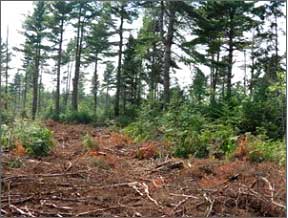 |
| A contract is complete only when all the signatories are satisfied that the contract conditions have been met. |
Conflict Resolution
Everyone usually hopes all details of a contract will be carried out satisfactorily, but there are often circumstances when this does not happen. Your contract should be the first tool for ensuring conflicts between yourself and a contractor are minimized. For this reason, contracts should be as detailed as possible.
In the rare event that things go wrong, it is often good to have a lawyer draft your contract – or at least be aware of its contents – should you require legal advice in a dispute. Of course, it is always preferable that a conflict should be settled amicably, and for this reason it is doubly important you obtain good references for your contractor, and you become familiar with his method of operations before he is hired.
If issues do arise, it is important you address them as soon as possible. This may involve halting the contractor’s work until the issue is resolved. Be aware, however, if wood has been harvested, a contractor may have recourse to be paid for harvesting work that has been completed.
Conclusion
Hiring and using a contractor can be both challenging and rewarding. It can also be the most progressive action you may take as a woodland owner. Contractors can accomplish tasks you may find difficult or impossible to do yourself. They usually have the expertise, experience and equipment needed to do the job well.
At the same time, everyone involved in managing your woodland should reduce the risks of property damage and personal injury. Even so, insurance is needed to verify you are covered should an event occur. For this reason, you should ensure both you and the contractor have sufficient insurance.
A clear, concise and comprehensive contract will outline the responsibilities of each party, so that everyone understands their roles in managing your woodland. Make a point of insisting a contract is the best way of guaranteeing a satisfactory outcome for everyone involved.
Finally, cherish your relationship with a contractor. Hiring a contractor may be the best action you have ever taken on the road to being an excellent steward of your woodland.
Module 14 - Hiring and Working with a Woodland Contractor -- UNDER CONSTRUCTION
Sample Harvesting Contract
Disclaimer
The information provided under the ‘Sample Harvesting Contract’ is intended to assist woodlot owners and harvesting contractors who wish to enter into a harvesting agreement. It is to be used as an instructional document only, not as a final agreement. It is the responsibility of the contracting parties to make sure that they understand the terms and conditions attached to the clauses. The Department of Natural Resources disclaims any responsibility from any misunderstanding and or conflict resulting from the use of this document and the sample clauses. The intended users should consult with their own legal counsel prior to entering into any contract or agreement to ensure all legal requirements are met with respect to their specific circumstances.
Module 14 - Lesson 2 - Case Study 2
Case Study 2
There are few woodland owners that know as much about the woods as Kelly Baker. He has been practically raised holding the reins of a team of horses, skidding logs, and he has spent more than half a century working the land on the family farm, which he now solely owned.
From the old pasture Kelly could see clear across the Bay of Fundy to Cape Blomidon, where on sultry days the fog laid spread like a grey blanket. He could tell if there was weather coming by the way the sky looked over the wide tidal flats. After all, it was the bay with the highest tides in the world, and that had to mean something.
Kelly Baker was in a fix. For decades he had logged the lower slopes of his property, never taking too much, so that the red spruce that grew so well on the south slope of the mountain continually regenerated itself. He picked trees here and there for harvesting, checking for soundness and straightness, always with an eye to where the tree should fall if it was cut. He was seldom wrong.
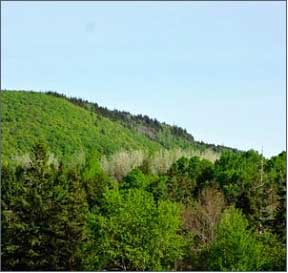
When he needed firewood he went further up the mountain, where the sugar maple grew tall and abundantly. He was careful to maintain the old woods road in good condition, since that was his only way in and out of his woodland. Kelly hoped he would never have the need to get out of the woods quickly in an emergency, but if he needed it the road was there.
Trouble was, Kelly was getting on in years, and he needed some money. He had even sold his old horse to a farmer in New Brunswick. The spruce he had had so little problem staying ahead of, was now so far beyond his ability to harvest and it pained him to even look at them. The groves of trees, so carefully considered for cutting in the past now stared back at him, almost in reproach.
He wondered about hiring someone to help him. A family he knew owned several large pieces of harvesting equipment - and the men to match – who could work 24/7. That was their way of putting food on the table and new pickups in the yard.
Thing was, Kelly could not abide clearcutting. For kilometers in every direction from his property on the mountain he could see the great expanse of the Cobequid Hills and the rents in the landscape where the forest had been harvested. Even now, when he needed money, he could not bring himself to subject the woods - where five generations of Bakers had worked - to being felled in one swoop.
Sure, the guys with the harvesters had come calling several times, and as they stared at the ground and kicked the tires of their new trucks, each successive offer had been greater. Kelly appreciated their straightforward approach. They were businessmen, and their business was doing well.
But Kelly had other ideas. For years he had enjoyed reading a monthly journal called Rural Delivery. It was the only magazine to which he subscribed, and he had a fondness for the articles that described real-life small-scale farming and forestry, because it awakened good memories of past times on the farm. From these articles he knew that there were other people that thought the way he did.
One day during a late winter storm that caked the house and barn in crusty snow, Kelly decided to place an ad in Rural Delivery. The ad stated:
Standing wood for sale, nearly all spruce, with good access. Partial cutting only, must be light on the land. Call for a tour.
The phone began to ring even before he had received the next issue of the magazine.
One call intrigued him. It was from a forester who worked for a woodland owner cooperative. Steve indicated he would like to come out the following week and have a look at Kelly’s woodland.
The snow crunched underfoot as Kelly and Steve made their way across the pasture to the edge of the white spruce stand. As soon as they entered the woods the snow level dropped and their pace quickened. Two deer melted away among the trees in front of them as they moved forward.
Kelly recounted the history of the farm, and stated he was the last of the Baker line that lived locally. To him, the old farm property was more than money in the bank. It was a legacy, the only physical remnant of his family’s history here on the mountain.
Steve understood. He told of his own family’s history in the River Hebert area, and how most of the family had scattered across the continent once the last wooden ship was built there. Times had changed, but valuable threads were still recognizable. Steve had an affinity for wood – perhaps some sort of genetic memory - that compelled him to study forestry.
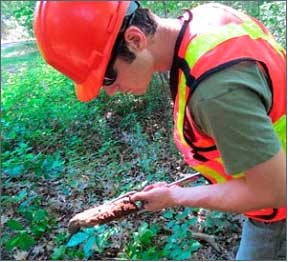
Another of those vital threads was the Baker farm. Kelly wished to conserve some of the family heritage that existed on the mountain. More to the point, he didn’t want to be the one to sell it all - to cut and run.
Steve pointed out to Kelly it might be important to take one step at a time, and before hiring a logger he should have a stewardship plan. The plan would be built around Kelly’s objectives and his need for income. Kelly agreed, as long as the costs were reasonable. For the first time, there would be a written plan for the Baker woods.
It was nearly two months before the Baker stewardship plan was read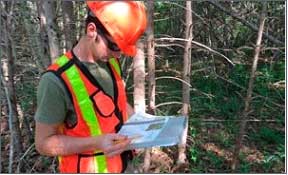 y. Steve had visited Kelly and his woodland twice more to cruise the property and to keep Kelly updated on his progress. Kelly was impressed with the forester’s thoroughness and attention to detail, and with his breadth of knowledge. The forester seemed to anticipate Kelly’s concerns, and the resulting plan was exactly what Kelly had hoped.
y. Steve had visited Kelly and his woodland twice more to cruise the property and to keep Kelly updated on his progress. Kelly was impressed with the forester’s thoroughness and attention to detail, and with his breadth of knowledge. The forester seemed to anticipate Kelly’s concerns, and the resulting plan was exactly what Kelly had hoped.
While tagging along with Steve one day, Kelly had asked him why he was taking the time to sample the soil with his soil auger. Steve explained not all soils were the same, and up here on the mountain it was very important to gauge the risk of trees being blown down by the wind. Kelly replied although he had been working up here for decades, he had only noticed a few trees had blown as a result of his “thinning”. It was true, Steve noted. He marveled at how wind-firm the trees up here seemed to be.
An old pasture which had grown up in white spruce was another story. These trees were starting to show signs that spruce bark beetles were weakening them. A number of trees had already died, and brown needles fell to the ground like rain. Other trees showed tell-tale cracks near their base, which indicated rot had set in. The two men nearly tripped over the tree roots which were spread across the ground like a giant spider’s web. It was clear this entire stand of white spruce would need to be harvested – and all at once.

Steve knew of a contractor who would be able to carry out the harvesting work. Jim, he said, had a small crew of two chainsaw operators, a small forwarder, or porter, and best of all, a horse. Jim had worked on several lots for the members of the woodland cooperative and had a good reputation as a reliable contractor.
It was important, Steve stated, that if Jim agreed to do the work a contract should be drawn up to ensure both Kelly and Jim knew what to expect of each other. It was obvious Steve firmly believed in contracts, and while Kelly didn’t much like paperwork he agreed to think it over once he knew the details. Meanwhile, Steve would try to contact Jim as soon as possible.
The following week Jim arrived at the Baker farm in his battered pickup. Kelly could sense he was a horseman right away, and the two were soon discussing whiffle-trees and the importance of getting horseshoe heels beveled just right.
Steve soon arrived and the trio set off to walk Kelly’s woodland. They all agreed the old pasture spruce should be completely harvested because of the extent of dying trees, since any trees left standing would certainly blow down. Here, Jim could use his forwarder to extract the wood to the side of the road. Steve indicated he could perhaps arrange to have the harvested site planted two or three years later, likely at little or no cost to Kelly.
Once they were back in the woods, it was not long before Jim expressed his enthusiasm for tackling the job of harvesting some of the red spruce and hardwood in a selection harvest. Most of the area was in a shallow valley which protected the trees from wind. Here, Jim stated, he could use his horse to extract the wood on some of the area closest to the road, and use his forwarder on the remainder.
Steve emphasized a contract should be the basis for doing any of the work, and offered to put one together. Jim already had Workers Compensation coverage for both himself and his employees, and also had insurance for public liability and property damage.
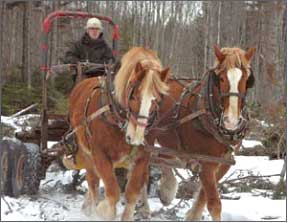 Kelly was familiar with the location of the boundary lines of the property and offered to clean them out and repaint the tree blazes that hadn’t received a fresh coat for more than twenty years. He would also make sure the farm gate on the woods road was left open while Jim was working there and while wood was being trucked. Steve noted all these details on the contract.
Kelly was familiar with the location of the boundary lines of the property and offered to clean them out and repaint the tree blazes that hadn’t received a fresh coat for more than twenty years. He would also make sure the farm gate on the woods road was left open while Jim was working there and while wood was being trucked. Steve noted all these details on the contract.
Jim agreed to pay Kelly every two weeks, based on the mill scale of the wood. The hardwood would be scaled at the landing by Steve, and Jim would make payments to Kelly based on this scale. Jim also promised every stick of wood on the landing would be trucked within a month of the end of the harvesting operation. Any damage to the road caused by trucks or equipment would be fixed by Jim. He would also ensure, because the operations would be taking place during fire season, adequate fire-fighting equipment would be stored on site.
Kelly liked this arrangement since Jim would need to truck the wood quickly. He had seen many small piles of wood beside roads in his travels. The piles had been there for months, even years, and most were decayed beyond the point of usefulness.
When the details of the contract were complete, Steve had both Kelly and Jim sign the document. Steve added his signature as a witness and eachwas given a copy. The real work could begin!
Sitting near his kitchen window overlooking his fields, Kelly was content. It was now high summer, the woods were dry and it was the perfect time for forestry work. Kelly watched as Jim’s forwarder was unloaded from its flatbed and began to gather wood that the chainsaw operators had begun cutting the week before.
Then he saw the sight that he was really anticipating – a pickup truck drawing a horse trailer up the hill towards his woods. Kelly’s face widened as he grinned, sprang to his feet and rushed out the door, leaving his half-finished cup of tea on the table.
Module 14 - Lesson 2 Quiz
| Questions: | 10 |
| Attempts allowed: | Unlimited |
| Available: | Always |
| Pass rate: | 75 % |
| Backwards navigation: | Allowed |
Module 14: Additional Resources
NS Department of Natural Resources
Forest Professionals
Registered Professional Foresters Association of Nova Scotia
Nova Scotia Forest Technicians Association
Woodland Owner Organizations
Federation of Nova Scotia Woodland Owners
Nova Scotia Woodlot Owners and Forest Fiber Producers Association
Nova Scotia Woodlot Owners and Operators Association
Harvesting and Silviculture Contractors
Nova Forest Alliance
Silviculture Assistance
Association for Sustainable Forestry